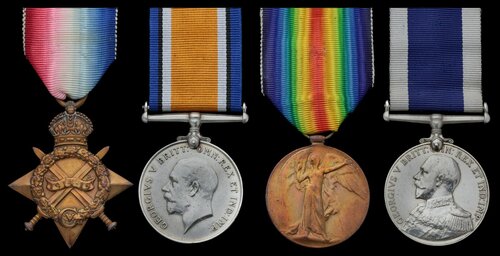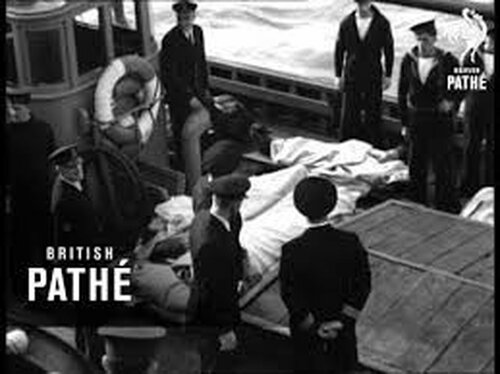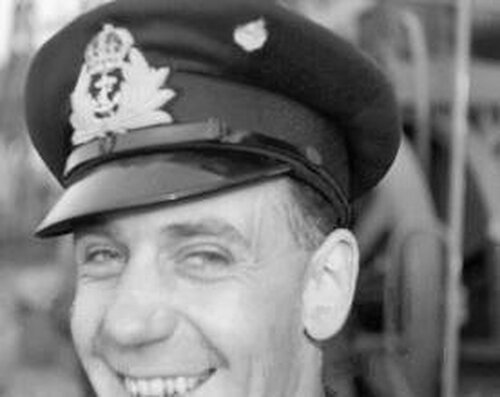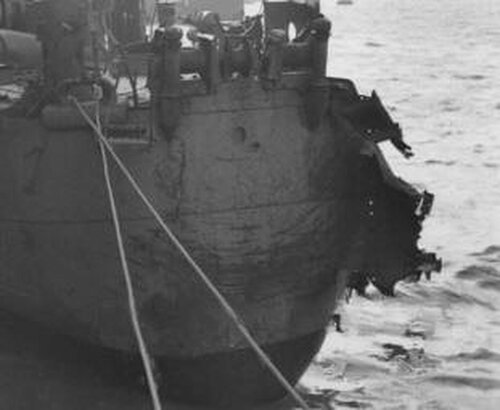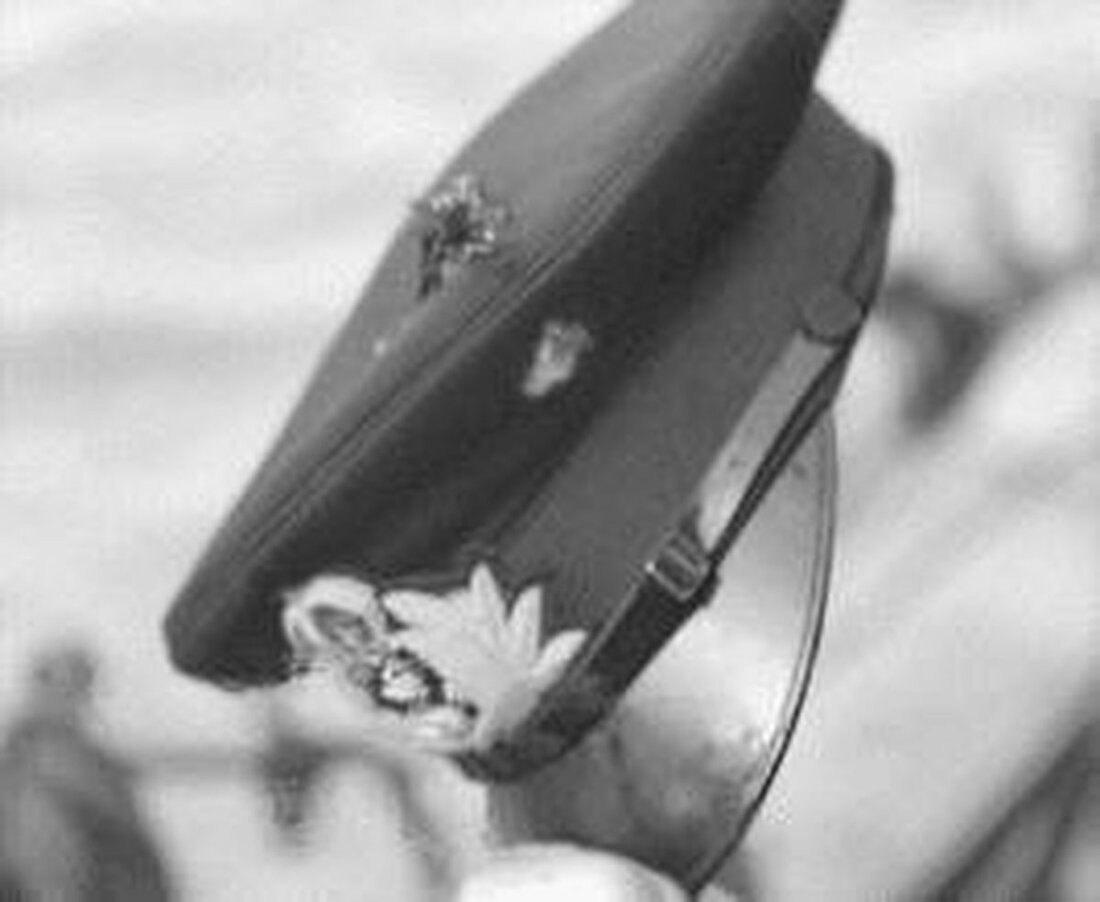Auction: 21003 - Orders, Decorations and Medals
Lot: 321
'How you fellows didn't all have a breakdown I don't know. It made me feel awful, leading the comfortable life I do, I can tell you…'
So states a letter from Desmond Curran, a Consultant Specialist, sent to investigate the state of H.M.S. Hussar's crew, who had reputedly 'cracked up' under constant air attack; the correspondence of Captain J. J. Youngs, R.N., as held by the Imperial War Museum, refers.
A Great War campaign group of four awarded to Stoker 1st Class W. C. Teague, Royal Navy, who later endured multiple enemy air attacks in H.M.S. Hussar in 1940
For remarkable footage of Hussar on one of those occasions - on her returning to port to disembark her wounded after being bombed on 15 May 1940 - see:
https://www.youtube.com/watch?v=OXJNUCl8oxc
1914-15 Star (K. 27115 W. C. Teague, Sto. 2, R.N.); British War and Victory Medals (K. 27115 W. C. Teague, Sto. 1, R.N.); Royal Navy L.S. & G.C., G.V.R., 2nd issue, fixed suspension (K. 27115 W. C. Teague, Sto. 1, H.M.S. Vivid), light contact marks, nearly very fine or better (4)
William Charles Teague was born in Paignton, Devon on 20 June 1897 and entered the Royal Navy as a Stoker 2nd Class in June 1915.
Following a brief spell in H.M.S. Forward, he served in the battleship Ajax from September 1915 until January 1916, and in the patrol boat P. 35 from March 1917 until February 1919.
Having then gained advancement to Stoker 1st Class and been awarded his L.S. & G.C. Medal in July 1930, he was pensioned ashore in June 1937.
H.M.S. Hussar: a harsh re-introduction to active service
Recalled shortly before the renewal of hostilities in June 1939, Teague joined the ship's company of the minesweeper Hussar, and remained similarly employed until October 1940. In that period, as cited above, Hussar was subjected to multiple air attacks.
The first - and most serious of these - took place on 16 May 1940, when she was sweeping off the Dutch coast and was hit by a bomb on the starboard edge of her quarterdeck. Three members of her crew were killed and a further 10 wounded, but she managed to make Harwich using her manual steering gear. Her arrival - and the subsequent disembarkation of her wounded - was, as cited, captured on the film, footage that revealed extensive damage and one very close call:
On 10 July 1940, Hussar was again bombed and damaged, off Orford Ness, and she was ordered to Chatham to be paid off. As revealed by the correspondence of Captain J. J. Youngs, R.N., held at the Imperial War Museum (IWM 92/50/1), she was indeed paid off in a 'sad affair which caused an awful stir':
' … After Dunkirk I returned to Hussar for three months at Harwich. You may remember about August we got down to about three ships due to enemy action and eventually so many people went sick in Hussar that I was unable to take her to sea, a sad affair which caused an awful stir in higher places. She was paid off on medical recommendations which were that the whole crew needed a change of scene … '
Those medical recommendations were made by the above cited Consultant Specialist, Desmond Curran, who sent the following letter to Hussar's skipper:
'Dear Captain Youngs,
I just wanted to thank you so much for your kindness and hospitality to me on my visit to the Hussar. Could you, should you be seeing your fellow officers, thank them for me too?
I have seen all sorts of grandees about it since - Rear Admirals Taylor and MacNamara at Chatham, and also a Staff Captain Faulkner there - who have a note to the effect it was not in the least your 'fault'. So I don't think you need worry about that … Have sent in a report at their request, saying Hussar was obviously a very 'Happy Ship' and that the men spoke most warmly of the officers - and putting forward various recommendations as a doctor about more regular leave, a shorter stretch at sea, age guides for mine escorts, occasional change of men - and in detail most of the points you fellows were kind enough to mention.
If it has any effect - and I hope it may for Admiral Sir C. Little seemed interested and issued some orders about the ages of men right away - I shall be very glad. How you fellows didn't all break down I don't know. It made me feel awful, leading the comfortable life I do I can tell you.
With all very best wishes and good luck - and again my thanks for treating an 'inquisitor' so kindly.
Yours very sincerely,
Desmond Curran
P.S.
Hope your chief gets a good leave - he needs it, (he's) a fine fellow.'
Postscript
Curran's 'age guides for mine escorts' undoubtedly applied to Teague, who was 43 years old at the time of the specialist's report. He was transferred to the escort Centurion in October 1940 and, in April 1941, to the depot ship Paris.
He was released from the service as 'Class A' in September 1945.
Subject to 20% VAT on Buyer’s Premium. For more information please view Terms and Conditions for Buyers.
Sold for
£180
Starting price
£110

